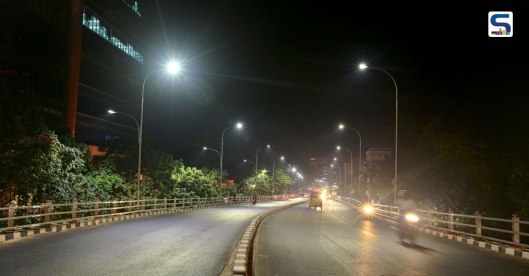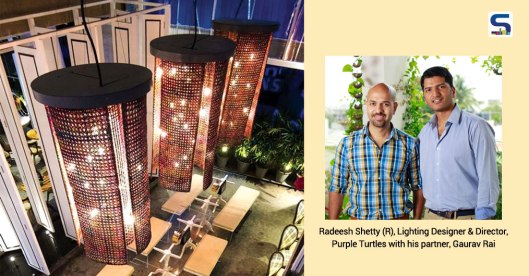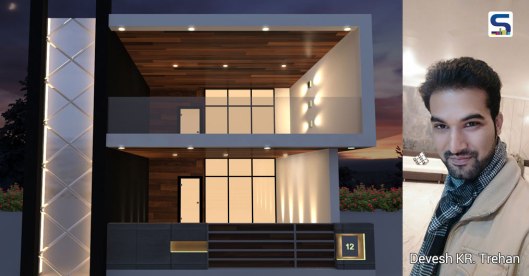Lighting Consultants And The Growing World Of Innovative Lighting Design
Lighting consultation and customized Lighting designs are slowly gaining ground in India. Projects in the West and the Middle East are quite advanced in terms of understanding the importance of having a Lighting consultant right from the initial stages of the project. Many companies in the field of Design and Architecture keep a team of designers with the sole purpose of designing lights and capturing the effects of it. With the world of IoT and options for lighting controls available today, it is important for understanding how much energy you can save with intelligent use of lighting sensors and use of technology rather than looking alighting just as an investment to experience space better.
Surfaces Reporter is glad to share interactions with Sumit Joshi, CEO & South Asia, Philips Lighting; Radeesh Shetty, Lighting Designer & Director, Purple Turtles; and Interior Designer Devesh Kr. Trehan from Elysian to understand the current scenario in Lighting Design and Consulting. Contact us with your designs & inputs at press@surfaces.in
How has the Lighting Market evolved over the past few years? Please elaborate the developments you have encountered.
Over the past few years, there has been a significant transformation in the lighting industry with the introduction of LED lighting. Its penetration has increased substantially over the past two years owing to enhanced awareness amongst consumers about its advantages, such as high durability and lower power consumption, in addition to their increased availability and reduced prices. LED’s are fast replacing conventional lighting at workplaces, public infrastructure, industries, and homes.
However, the latest trend in the lighting industry has been the emergence of Connected lighting marking a significant shift by transforming lighting from a commodity product to a fully integrated lighting system that can seamlessly connect with a wireless network or Ethernet, allowing users to remotely control and monitor their lighting systems. The new LED lighting systems can now connect and interact seamlessly with smart controls, networks, devices as well as Apps to offer a customizable and tech-enabled lighting experience, paving the way for a fully digital world.
Philips Lighting foresees that this technology will significantly enhance a consumer’s lighting experience at home and drive new business value for professional users.
The new LED lighting systems can now connect and interact seamlessly with smart controls, networks, devices as well as Apps to offer a customizable and tech-enabled lighting experience, paving the way for a fully digital world. Philips Lighting foresees that this technology will enhance consumer’s lighting experience at home and drive new business value for professional users.
How are LEDs changing the lighting industry?
The introduction of LED lighting has been one of the most significant developments in the lighting industry over the past few years. LED’s have transformed lighting from analog to digital, enabling users to remotely control and monitor them. The digital capabilities of LEDs enable tremendous customization in terms of light output and applications.
Growth in population and increased urbanization require more and better lighting, while resource constraints and the realities of climate change demand maximum energy efficiency. LED technology is uniquely positioned to deliver on both counts: bringing better quality lighting into every home, business and public space & meeting the demand for additional light points – while delivering maximum levels of energy efficiency. A global transition to LED technology will bring an energy savings of 53% by 2030. In the city, for instance, where public lighting comprises around half of the local government’s energy bill, by switching to LEDs a city can slash its energy bills instantly by 50%, freeing this money to be invested elsewhere & in schools, hospitals, infrastructure. But the potential is even greater, as when LED lights are connected and controlled wirelessly via the Internet of Things, energy usage for lighting can be reduced by as much as 80% compared to incandescent technologies.
Enlighten us about the growing importance of lighting control systems.
Lighting control is the ability to regulate the level and quality of light in a given space for specific tasks or situations. Controlling light properly not only enhances the overall lighting experience It also helps to conserve energy by switching off lights when not in use.
From simple wall-mounted dimmers to comprehensive lighting management software systems, Philips Lighting offers a comprehensive range of control solutions for incandescent, fluorescent and LED lamps and luminaries. These controls have four key applications:
- Enhance Sustainability: Lighting controls have the ability to reduce energy consumption, by as much as 55%, as well as improving the ambience of the environment through tailored lighting solutions.
- Customization: Lighting controls can be customized as per requirement, ranging from simple switches to advanced integrated systems made up of user interfaces, sensors, controllers, drivers and software.
- Dynamic in-store lighting: Lighting can enable stores to create irresistible window displays and bring products to life through innovative lighting. Lighting controls are the perfect way to set the right lighting mood in stores, helping them attract customers and enhancing their overall shopping experience.
- Optimising Controls for Hospitality: Control systems from Philips Lighting enables guests to control and customize the lighting of their room through one intuitive interface. The control system can be integrated to the hotels management system to allow for real-time room updates.
Please share ‘what’s in’ in terms of products, design, and innovation.
At Philips Lighting, we are committed towards developing state of- the-art innovative and sustainable lighting products that are designed for customer delight.
We recently launched Philips Hue White Ambiance connected LED home lighting system in India. This range enables users to select the right light level and color temperature of white for their daily tasks and routines, thereby helping to promote their health and wellbeing. The system has preset light recipes to help users relax, read, concentrate and energize. It enables to create and control home lighting using their Smartphone or tablet and works seamlessly across both iOS and Android platforms. It is also compatible with all major smart home hubs, including Apple HomeKit, Google Home, and Amazon Echo.

Growing population and urbanization require more and better lighting, while resource constraints and the realities of climate change demand maximum energy efficiency. LED technology is uniquely positioned to deliver on both counts. A global transition to LED technology will bring an energy savings of 53% by 2030.
We have also introduced several innovative products like Stellar Bright 2-1 LED bulb which is a bulb that can function in both regular and night mode Linear LED Bulb that is a LED bulb with a linear illumination surface and our Astrasleek LED batten – the worlds first integrated glass LED batten.
How has the consumer behavior changed over the years for lighting design?
Consumers in India are increasingly becoming more aware of their responsibility towards the environment and are switching over to energy efficient lighting. They are looking forward to smarter and energy efficient homes, offices, retail outlets, and thereby fueling demand for LED lighting. We have witnessed a significant increase in demand for our LED lighting products, which is a testimony to the increased awareness of LED lighting amongst consumers and their consideration towards conserving energy and protecting their environment.
India is home to the worlds youngest population that is increasingly smartphone savvy and an early adopter of latest technology products and trends available globally. At Philips Lighting, we have witnessed a growing awareness about IoT and connected lighting amongst consumers. We introduced our Philips Hue product range specifically targeting this tech-savvy population that is keen on enhancing their homes and lifestyle using technology.
Radeesh Shetty and Gaurav Rai, Lighting designers, Purple Turtles
How has the Lighting Market evolved so far?
The mindset around lights has evolved drastically. Today we are dealing with smart customers, who are well travelled and well researched. They have access to various inspirational websites and channels and social media like Pinterest and are bubbling with ideas. Not only this, there is a wide acceptance towards materials. Gone are the days of chandeliers and crystal lights, people are looking for a unique amalgam of materials.

Architects and designers are ready to walk an extra mile just to customize the fixtures that their sectors want and it’s not limited to residential or corporate but has expanded largely to hospitality and retails as well.
The biggest change would be the integration of technology. Automation, dimming systems and controlling color temperatures are some of the readily available and not so expensive facility now.
Comment on the role of lighting consultants in projects?
It’s become very important to have a specialist in the lighting department so that optimum light is maintained at any given location.
Every outlet is trying to be LEED certified which means they’re helping the environment by saving electricity, for which they need an expert so that they don’t overdo it. Lighting Consultants now specialize in customizing lights for the same.
How are LEDs changing the lighting industry?
Its established now that LED is a sustainable and eco-friendly alternative to all the current choices. But slowly its retrofitting all the gaps and has the potential of replacing almost any lighting alternative.
Enlighten us about the growing importance of lighting control systems.
Lighting control systems are becoming increasingly important because of its accessibility and convenience. Smart technology is not only sustainable but just by integrating simple modules people can now control lights from a distance on their mobile phones and tablets.
Please share what’s in, in terms of products, design, and innovation!
As a brand, we are constantly exploring new materials and even our consumers are looking for innovation. Currently, we are working with materials such as concrete, cork and new fibres.
How are your designs catering to ‘green’ aspect?
Our choice of materials in itself an indication to how our brand is catering to sustainability. Our materials are locally available and sourced. Apart from this, all our methods applied for creating any fixture is eco-friendly too.
How has consumer behavior changed in choosing effective lighting solutions?
They’ve become smarter and more accepting than before. Well travelled and researched, they know exactly what they want. Not only this, everyone needs a unique lighting solution for themselves now, for which our designers don’t mind putting in some extra effort.
Email: info@thepurpleturtles.com
Devesh KR. Trehan, Lighting Consultant & Interiors Designer, Elysian Designers
As a Lighting Consultant, what are the expectations from the client?
People are becoming more aware of the role lighting can play in design. However we are still lacking educated customers, I presume it would be the correct word in this field of lighting. Often we see a demand for an effect or a particular light that they saw somewhere without being fully aware of its link to the theme or backdrop, functionality. That said, it is unfair to expect from them. As long as there is respect for the profession, we should play a role in educating the clients. Certainly, people are demanding more and will not settle for less.
Whats in when it comes to design?
Indirect lighting hands down. Subtly done… understated. Theme Lighting with a focus on functionality would be a close second. The customer’s sense of design is seeing an upward trend.

Enlighten us about the growing importance of lighting control systems.
From my experience abroad, I can with certain authority say that lighting control and automation systems are very important and can’t be ignored for long. We need it to be commonly and easily available. With the energy challenges and demands we have as a country, immense energy saving happens in places like Dubai, where light and motion sensor, as well as timer-based lights, are installed in common areas of building and community centers and even ventilation systems. This reduces energy consumption drastically. We need it to be more commonly available so the fear of the common man in terms of service and over the top expenses can be tackled.
How much do architects and designers give importance to Human-Centric lighting today?
I can be speaking on my behalf that Human Centric Lighting will be given importance by anyone and everyone who is focused on the end use i.e the client whose habitat is being designed. Their comfort is of utmost importance and has always played on our minds while designing and giving the maximum options and flexibility.
What are your favorite lighting products, besides LEDs, of course?
I am biased to app-based lighting system along with app-based automation. They liberate you endlessly and can handle every mood and occasion perfectly.
How much has IoT (Internet of things) penetrated the lighting industry?
App Based and Mobile controlled lighting systems are picking up. That’s where I see it going. Challenges are going to be in terms of creativity and innovation to make lighting a user based/centric experience similar to GUI in computers.





Comments
Post a Comment